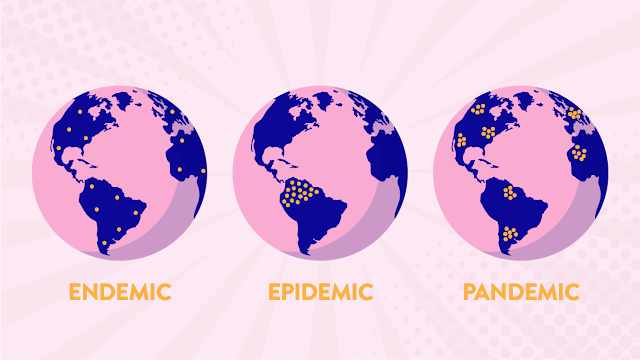TUBERCULOSIS-A LETHAL DISEASE
With new information this festive season.....
Tuberculosis
Compared with other disease caused by a single infectious agent known as MYCOBACTERIUM TUBERCULOSIS (which is a bacteria).
It is second biggest killer globally. According medical news in 2015,1.8 million people died from disease, with 10.4 falling ill.
Some history about disease, In 1882,German microbiologist ROBERT KOCHS discovered it. As he discovered it is known as kochs disease.
United nations predicted that TB could be eliminated by 2025.
In 1993 WHO declared TB as global emergency, first disease which is labelled as such.
Facts of Tuberculosis
- TB is airborne disease, means the bacteria can spread through air from person to person. TB pathogen can't thrive on surface, so by shaking hands or by food or drinks it is not spread.
- WHO estimates that 9 million people a year get infected with TB.
Doctors divide TB ,
LATENT TB:-The bacteria remain in body in an inactive state. No symptoms are seen,but they can be active when immune system is compromised in a conditions like HIV, malnutrition or people who smoke.
ACTIVE TB:-The bacteria is active and present with clinical symptoms.
Clinical presentation of TB
- Loss of appetite
- Weakness
- Weight loss incredibly
- Fever with chills
- Night sweats
- Severe cough with sputum last for longer than 3 weeks
- Blood stained sputum
- Chest pain
- Difficulty in breathing
- Spine involvement which is also known as POTTS DISEASE ,in which irritability of nerve roots,pressure abscess, collapse of vertebrae body is clinical presentation. If left untreated it can lead to complications like paraplegia, khyposis etc.
- Brain meninges involvement lead to TB MENINGITIS. If left untreated can be fatal.
- Liver and kidney involvement may lead impairment of waste filtration and lead to blood infections.
- Heart involvement which is rare but can be happen which lead to inability to pump blood resulting cardiac tamponade.
People can use face mask to cover mouth.
Can cover mouth with handkerchiefs.
Keep rooms fully ventilated.
TB vaccination i.e., BCG vaccination is given to new born for prevention of TB.
DIAGNOSIS
To check TB doctors will use sthescope to hear lungs sound like low breath sounds,crackles because of secretion present in lung,crepitus.
Doctors check for swelling of lymph nodes.
Clinical presentation and medical history is very much useful to diagnose TB.
The most common diagnostic test is TUBERCULOSIS SKIN TEST OR MOUNTOX TEST. The test is performed by injecting 0.1ml of tuberculin purified protein derivative in surface of forearm intradermally. Skin reaction is noticed between 48 to 72 hours.
Reaction should be measured in millimeters of induration( palpable,raised,harden ,swelling area).
Unfortunately, the skin is not 100% accurate.
There are some other tests to confirm TB,
Blood tests including ESR(erythrocyte sedimentation rate),pCr(polymerase chain reaction) .
Chest XRay for pulmonary TB
Spine Xray for Potts disease
Bone xray to check involvement
Sputum analysis to confirm pathogen.
If brain meninges involvement is present than CSF culture (cerebrospinal fluid culture)
Treatment of Tuberculosis
The medical management of TB is as long course of antibiotics for 6 to 9 months.
Antibiotics include,
Isoniazid
Rifampin
Ethambutol
Pyrazinamide
If drug resistant TB is involved than combination of antibiotics is given called fluoroquinolones and injectable medications such as amikacin and capreomycin.
As it is long course of medications there Are side effects of medications which includes,
Nausea and vomiting
Loss of appetite
Yellowing of skin
Dark urine.
SURGICAL TREATMENT IS ALSO SOMETIMES NEEDED if lobes of lungs which is damage it is removed called lobectomy.
If heart involvement leads to cardiac tamponade release of pressure from heart is done by incision on pericardial membranes.
If spine and vertebrae are badly damaged than decompression of vertebrae surgery is first line treatment.
As PHYSIOTHERAPY is helpful in all disease it is also needed in TB.
In lung TB secretion are present in lobes of lung which leads difficulty in breathing and decreased oxygen in blood. Physiotherapist help to remove secretion by postural drainage, different breathing techniques, percussion, huffing and coughing, aerobic exercise to increase the efficacy of life.
For POTTS DISEASE ,spine involvement depends on which part of spine TB is involved. Complications of Potts disease is from deformity to paraplegia.
After spinal surgery physiotherapy is mandatory, which includes,
Spinal stabilization exercises
Trunk strengthening
Maitland techniques for spine
Aquatic therapy
TENS for pain relief
Aerobic exercise
If neurological involvement is present physiotherapy is mandatory to muscle mass of legs and upper body part strengthening for mobility purposes.
There is vast treatment line for Potts disease in physiotherapy. I had try to cover all parts.
PHYSIOTHERAPY CANT CURE TB BUT WITH MEDICAL MANAGEMENT IT CAN ADD UP PROGNOSIS AND HELP THE PATIENT TO LIVE LIFE EFFICIENTLY.
REMEMBER THE MEDICAL MANAGEMENT OF 6 TO 9 MONTHS IS MUST TO DISPROOF THE FATALITY OF TB.
For POTTS DISEASE ,spine involvement depends on which part of spine TB is involved. Complications of Potts disease is from deformity to paraplegia.
After spinal surgery physiotherapy is mandatory, which includes,
Spinal stabilization exercises
Trunk strengthening
Maitland techniques for spine
Aquatic therapy
TENS for pain relief
Aerobic exercise
If neurological involvement is present physiotherapy is mandatory to muscle mass of legs and upper body part strengthening for mobility purposes.
There is vast treatment line for Potts disease in physiotherapy. I had try to cover all parts.
PHYSIOTHERAPY CANT CURE TB BUT WITH MEDICAL MANAGEMENT IT CAN ADD UP PROGNOSIS AND HELP THE PATIENT TO LIVE LIFE EFFICIENTLY.
REMEMBER THE MEDICAL MANAGEMENT OF 6 TO 9 MONTHS IS MUST TO DISPROOF THE FATALITY OF TB.
As TB is vast topic , I had tried to cover all aspects of the same.If any queries you can be in touch with my mail.
STAY




















Really informative
ReplyDelete